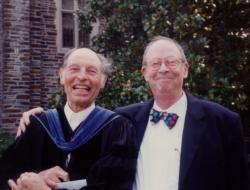
Nobel-prize winning physicist Robert C. Richardson, who earned his Ph.D. from Duke and later served as a university trustee, died Feb. 19 in Ithaca, N.Y. He was 75.
Richardson, a physicist at Cornell University, shared the 1996 Nobel Prize for his work on superfluidity in helium-3, a breakthrough in low-temperature physics. He discovered the low-temperature phenomenon in 1972, building on work he had done as a graduate student at Duke in the 1960s. He earned his Ph.D. from the university in 1966 under the supervision of physicist Horst Meyer.
"Bob Richardson was a brilliant scientist with a passionate love for Duke. As a graduate student here, he began the research that won him the Nobel Prize in physics, but for all his accomplishment, he remained wonderfully modest and down-to-earth," said Duke University President Richard Brodhead. "With his love of academic life and absolute devotion to this university, Bob was a great trustee, and he and Betty have remained close friends of many, and regulars at the ACC tournament. Duke University mourns the loss of this great friend."
Richardson served as a member of the university Board of Trustees from 1997-2007 and visited campus often. He attended the 2011 ceremony where Harvard physicist Lisa Randall received an honorary doctorate, and afterward showed Duke physicist Dan Gauthier the labs where he did his earliest investigations of low-temperature physics. Richardson received an honorary degree from Duke in 2012.
"Bob was still very excited about the experiments he did here and also very supportive of how the university has advanced and transformed the scientific research on campus over the years," said Gauthier, the Robert C. Richardson Professor of Physics.
"He was an amazing scientist and a force in the field of physics and in science in general," Gauthier said, adding that he was, and still is, honored and humbled to have received the professorship carrying Richardson's legacy.
Richardson had a "very keen and enthusiastic mind, was both very good in designing and constructing equipment, in testing it, in performing experiments, and later in figuring out what the results meant and in devising a rigorous analysis," Meyer said. "He was very quick in understanding what going on. And then, he was a very persistent and hard worker, all qualities that much endeared him to me and were admired by his colleagues."
Meyer oversaw Richardson's Ph.D. research at Duke on nuclear spin interactions and ordering in solid helium-3. The experiment where Richardson and his collaborators discovered superfluidity in helium-3 was a continuation of his graduate work, Meyer said, adding that he continued to correspond and visit Richardson throughout the rest of his work and life in Ithaca, NY.
In his autobiography, Richardson writes: "I had a glorious time at Duke. I made strong friendships, which have been maintained through the rest of my life. I met my wife, Betty McCarthy, there." Meyer said this might help to explain the close ties Richardson kept with the university after he left.
"Robert was among the most distinguished alumni the physics department has ever educated. We are extremely proud of all he has accomplished as a scientist and as a human being," said Haiyan Gao, current chair of Duke's physics department. "He will be deeply missed by everyone who has interacted with him."
Duke is flying its flag at half-staff in Richardson's honor. Information on funeral services has yet to be released.